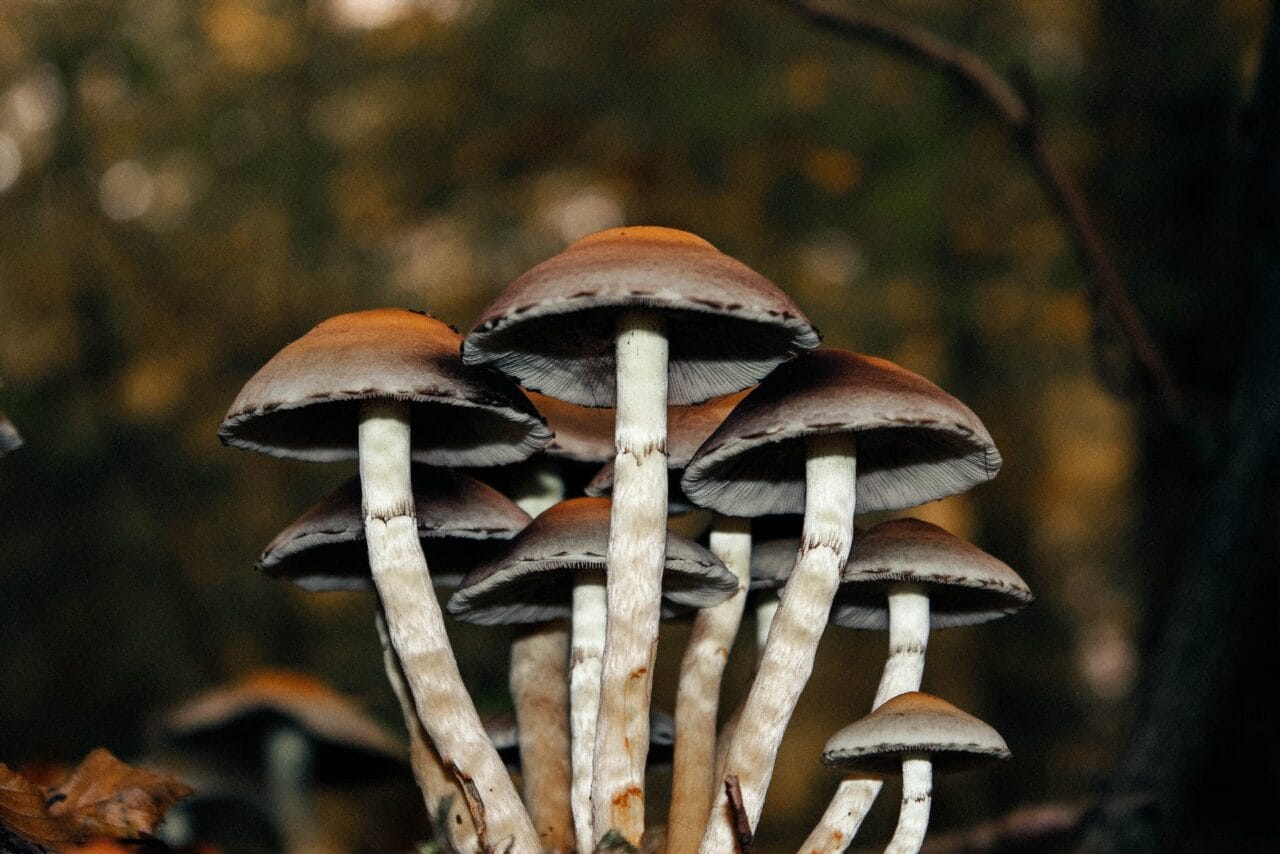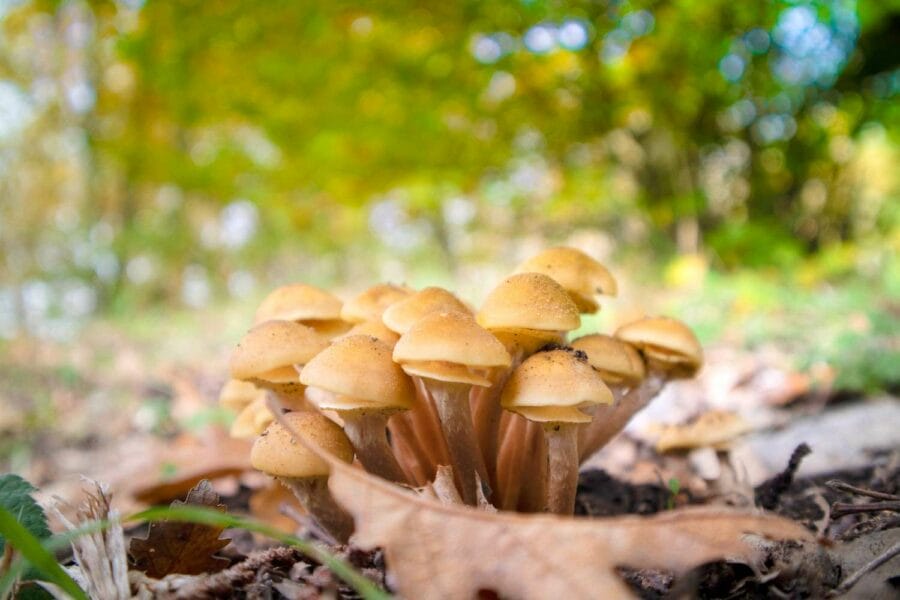Psilocybin, a psychoactive compound found in magic mushrooms, is often consumed recreationally for its euphoric effects and hallucinogenic properties.
Aside from mind-altering effects, ongoing research suggests psilocybin’s potential for aiding in chronic pain relief.
This article shares a case study demonstrating the possible benefits of microdosing mushrooms for chronic pain mitigation.
Key Takeaways:
- Microdosing mushrooms could provide both immediate and lasting pain relief.
- Compared to traditional pain medications, psilocybin microdosing, when consumed in small quantities, tends to exhibit fewer side effects.
- Psilocybin interacts with the serotonin 2A (5-HT2A) receptors, which can help alleviate pain and other conditions.

The Study
The study, “Microdosing Psilocybin for Chronic Pain: A Case Series“, led by Dr. Matthew Lyes and his team from the Division of Pain Medicine at the Department of Anesthesiology, University of California, San Diego, investigated the effects of self-administered psilocybin microdoses on three patients suffering from chronic pain.
Three Case Studies, One Common Result – Chronic Pain Reduction
Patient # 1
| AGE/ GENDER: | 37 Male |
| PAIN TYPE: | Neuropathic pain presenting beneath the site of a spinal cord injury. |
| INITIAL PAIN INTENSITY: | Initially 4 to 5/ 10, increasing to 8/ 10 later in the day |
| PSILOCYBIN DOSAGE: | 250 mg of ground mushroom for less than 6 months |
| OUTCOME: | Discontinued use of prescribed pain medication, reduced muscle spasms, improved bowel movement efficiency. No signs of rebound pain or withdrawal symptoms observed. |
| The patient reported that unlike his regular medications, which merely dulled the pain, psilocybin effectively eliminated it, lowering his average pain level from 5 to 0. | |
Case Study Analysis: Patient #2
| AGE/ GENDER: | 69-year-old female |
| TYPE OF PAIN: | Complex Regional Pain Syndrome (CRPS) |
| INTENSITY OF PAIN: | Generally between 5 and 7 out of 10, but can increase during physical activities or during pain flare-ups |
| PSILOCYBIN DOSAGE: | 500 mg daily for 7 to 10 days with 2 to 3 days of rest periods for a year. Dosage increases to 750 mg to 1 gram during pain flare-ups |
| IMPACT: | A decrease in pain by 80% for 3-4 hours, gradually reverting to initial levels after 12 hours. Complete relief from pain (90%-100%) lasts 6-8 hours, returning to initial levels after 18 hours. |
| The patient experiences a reduced appetite without the presence of nausea. Disorientation or unsteadiness in walking is observed when the dosage is increased (750 to 1000mg). | |
Case Study Analysis: Patient # 3
| AGE/ GENDER: | 40-year-old female |
| TYPE OF PAIN: | Lumbar radiculopathy and neuropathic pain |
| INTENSITY OF PAIN: | 8 out of 10, rising to 10 out of 10 during physical activities |
| PSILOCYBIN DOSAGE: | 1000 mg from a mushroom chocolate bar every two months. |
| IMPACT: | Significant relief from pain without any psychoactive effects. Increased flexibility and functionality have been noted. Pain gradually reverts to initial levels over a span of 2-4 weeks. Repeated doses enhance control over pain. |
| The patient does not experience any significant physical, cognitive, or behavioural side effects. Her mood remains relatively constant. She continues her regular dosage of her SSRI for managing depression throughout the psilocybin treatment period. | |
Deciphering Pain Management with Psilocybin
Continuous somatic and visceral pain signals can strengthen certain neural pathways due to peripheral and central sensitization, causing a chronic experience of physical and emotional pain. Psychedelics like psilocybin can activate 5-HT2A receptors, potentially reprogramming the brain areas related to neuropathic conditions.
One patient reported persistent pain relief lasting for several weeks. This suggests that after direct stimulation of the 5-HT2A receptors, there may be a central regulation of pain perception and adaptability of synapses.
Possible Side Effects of Psilocybin vs. Traditional Pain Relievers
| PSILOCYBIN (Based on Studies) | TRADITIONAL PAIN RELIEVERS |
| Muscle spasms | Nausea |
| Diminished appetite | Stomach discomfort |
| Confusion | Migraines |
| Unsteady gait | Addiction |
| No change in mood | Drowsiness |
Potential Future Studies on Psilocybin
After examining the experiences of three subjects, the research team highlighted certain areas that require further study due to their potential benefits.
- Small psilocybin doses might provide immediate and potentially enduring relief from neuropathic pain, without inducing physical tolerance or addiction.
- Examine the effects of different treatment strategies in combination with psilocybin. For example, patient #3 reported an amplified pain relief effect when psilocybin was administered alongside physical therapy.
- Small doses of psilocybin could potentially offer pain relief even without psychotherapy, as indicated by this case study. The researchers propose that incorporating therapeutic guidance might enhance or extend the therapeutic outcomes.
Study Limitations
Despite the encouraging findings in the subjects, it’s crucial to recognize the limitations acknowledged in this study.
- The small sample size might not be a comprehensive representation of all individuals experiencing neuropathic pain.
- The study did not involve any subjects who had no response to psilocybin.
- No assessments were carried out before and after the treatment to determine the impact of psilocybin on psychiatric disorders such as depression and anxiety.
- Most of the data was self-reported by the subjects.
- The presence of the interviewer and potential bias towards psilocybin could have influenced the participants’ responses.
- The study did not investigate the potential influence of the placebo effect.
- The study did not measure the psilocybin content in each mushroom.
Microdosing Mushrooms: An Overview
In this study, patient #1 and patient #2 consumed a microdose of psilocybin in a powdered form obtained from dried mushrooms, whereas patient #3 combined it with chocolate. There are several products specifically designed for psilocybin microdosing, a few of which have been compiled below.
Dry Mushrooms
The specific strain used in the study wasn’t mentioned, but the following strain could be a suitable starting point for those new to the experience.
- Golden Teacher: This is a common strain of magic mushrooms that’s widely available.
- Amazonian Cubensis: This strain is known for its user-friendly nature and cognitive benefits.
- Cambodian: The use of Cambodian cubensis mushrooms for microdosing may improve focus, social awareness, and mood.
Microdose Capsules
- Euphoria Psychedelics – Micro Calm Capsules: This blend combines Ashwagandha, Reishi, CBD, Valerian root, and Psilocybin Mushrooms, ingredients known for their anxiety and stress-relieving properties.
- Ground Sounds – Microdose Capsules – Champion Lover: This unique mixture provides three dosage options: 50mg, 100mg, or 250mg of pure psilocybin paired with reishi, cacao, cordyceps, and maca.
- Kind Stranger – Brighten Capsules 250mg: These capsules feature the Golden Teacher strain, renowned for promoting clarity, boosting creativity, and enhancing focus.
Using Psilocybin for Pain Relief
While the research into the analgesic effects of mushrooms is still nascent, both anecdotal reports and small-scale studies offer promising insights.
Such instances underscore the necessity for more rigorous studies into the potential advantages of psilocybin, class=”wp-block-list”>
Especially in the field of managing chronic pain, psilocybin is making considerable strides. Before its widespread acceptance for pain relief, inspiring case study reports have given hope to those grappling with chronic pain.
Frequently Asked Questions
What effects does microdosing psilocybin produce?
Psilocybin primarily activates a serotonin receptor known as “5-HT2A” in the prefrontal cortex, leading to two main outcomes:
- Generation of “Brain-Derived Neurotrophic Factor” (BDNF)
- Enhanced “Glutamate” transmission
Besides, psychedelics foster connections between less frequently interacting brain areas. This novel connectivity is a result of psychedelics’ ability to decrease the activity of the “Default Mode Network” (DMN), which is involved in various cognitive functions, such as daydreaming, introspection, and thinking about past and future events.
What is the most recognized benefit of microdosing mushrooms?
Microdosing can potentially enhance mood, productivity, creativity, and focus. Its most thoroughly researched benefit is its effect on mental health.
In November 2022, COMPASS Pathways, a mental health company, disclosed the findings of their extensive phase 2b trial, a randomized and double-blind study. Their research indicated that a single dose of psilocybin significantly reduced depressive symptoms compared to a placebo. Participants who were given a higher dose of 25 milligrams showed a persistent antidepressant response at the twelve-week follow-up.
A study appearing in the Psychiatry Research Journal highlighted that psilocybin is more effective than traditional antidepressant treatments.
How can you determine your dosage?
Start with a 0.1-gram dose of psilocybin mushrooms on the first day. If you don’t achieve the desired effects, you can gradually increase your dose by 0.05 grams on subsequent microdosing days until you reach your ideal level.
Individuals with a history of psychotropic drug use may need to increase the dosage to 0.5 grams to attain the desired effects.
What precautions should be taken before consuming mushrooms?
- Set aside some time to understand why you have chosen to microdose on a specific day.
- Take a moment to reflect and acknowledge your current emotional or mental state. Identify the emotions or mindset you believe will be advantageous for you that day.
- Once you have clearly defined your objectives, write them down. Casting your goals as affirmations can serve as a potent tool to enhance your continuous evolution.
- Focus your intention on the experience you want to create, rather than what you hope to evade.
- Consume it on an empty stomach, preferably an hour before your first meal of the day.
What frequency is suggested for consuming microdoses of mushrooms?
Various well-founded protocols suggest organized microdosing schedules for psychedelics. These protocols mainly differ in the number of “off” days they prescribe, which are the days you abstain from microdosing.
The most common protocols recommend including 1-3 rest days between microdoses to align with the body’s natural tolerance mechanisms. The three protocols discussed in this context are the Fadiman Protocol, the Stamets Stack, and intuitive microdosing.




